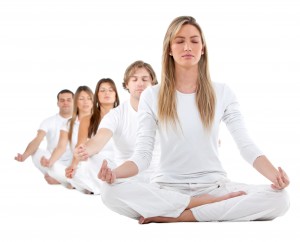By Adam Cantor, MS, LAc
Guest writer for Wake Up World
“I have so much to do today that I am going to meditate for two hours instead of one.”
Today, perhaps more than ever, illness of the body is rooted in the functioning of the mind. We are anxious, wound up, pent up and frustrated, and our emotions are making us sick. There are however natural remedies to living a happier, healthier and more carefree existence without needing to rely on psycho-pharmacopeia.
One of the most powerful solutions is meditation; but the very mention of the “m-word” conjures up images of monks chanting, new age hipsters sipping wheat grass, incense burning in yoga studios and bongos playing in the background. The purpose of this article is to illustrate without too much science or Sanskrit, quite simply that everyone can meditate; anyone can learn how and no you don’t have to chant, do yoga or otherwise change who you are to become proficient.
We often think of meditation as some sort of spiritual or religious practice. In reality though, meditation is the process of discovering who you truly are, a notion that can be either incredibly exciting or horribly terrifying. Nevertheless, after a period of regular practice, that will cease to matter as you discover some level of inner peace. It may seem odd to some, but by clearing your mind and becoming mushin no shin (Japanese term that translates into “mind without mind”), you transition emotionally, ready to face the world, more focused and relaxed.
[pro_ad_display_adzone id=”110028″]
Mind Your Emotions
There is a general consensus among the medical community that much of the illness plaguing modern society, such as heart disease, cancer, hypertension and diabetes (just to name a few), is greatly exacerbated by chronic stress. During the age of the caveman we needed to run from wild animals in order to survive, our “fight or flight” response was a daily necessity to make it through to tomorrow. Today however, our social self and our reactions to the world around us trigger this instinct far too often. Chronic stress keeps us running on adrenaline and stress hormones such as cortisol, leading to systemic inflammation and a deterioration of overall well-being.
Stress begins with how you think and how you think greatly impacts how you feel, this is known as psychoneuroimmunology. “When your thoughts create strong emotions—whether positive or negative—your brain releases hormones that spread the emotional news to every system of the body. Called neuropeptides, these hormones are informational molecules that telegraph messages to any cell in the body that has receptors for them [1].” When you have negative thoughts (stress, anger, depression, frustration, anxiety, etc.), you trigger a chain-reaction of events that elicit a physical response. The more common these thoughts are and the longer they last, the more likely they are to manifest in a physically perceptible manner.
But I Can’t Meditate…
Imagine for a moment that you’re standing at Grand Central Station waiting for a train but instead of boarding one train, you jump from train to train every few seconds. This is how the untrained mind operates: the train to your shopping list, a train to the bills or the family reunion, childhood memories, etc. Only once in a rare while does our train hopping get us where we truly want to go. As you develop your mind through meditation, it becomes easier to take the train you need.
There is a great expression in the Zen tradition of meditation, “invite your thoughts in but don’t serve them tea.” How simple yet poignant. When sitting (meditating) you don’t want to block out your thoughts or consciously engage them either, just learn to let them fly away like helium filled balloons drifting in the infinite sky. Thoughts will always present during meditation, no matter how experienced you are. The main difference between the novice practitioner and the advanced is how much those fleeting thoughts are able to derail your clarity.
Be Happy
Meditation allows us to clear the clouds of negative thought and emotion from the space that is our natural mind. These clouds are a mere distraction from happiness and as a result, people seek contentment outside of themselves; falsely believing that happiness cannot stem from within. The fleeting moments of happiness from external sources (people, experiences, material possessions, etc.) are bound to change or not always be with us and once again, we are left feeling empty. The one location we can find steadfast peace is within.
The mind is truly amazing: if consistent negative thoughts can slowly put us to ruin, imagine the power of unwavering positivity and happiness. We must learn to recondition the mind and reprogram it away from addictions to stress, tension, anxiety, anger, helplessness and depression. Most of us know someone who identifies him/herself as being sickly or always in pain. Often, these same individuals are resigned to accepting their life this way and blindly believing there is nothing they can do to change their situation. After all, this is how they identify themselves and changing their discomfort means reinventing who they are in some respects. Those living with chronic stress and/or pain begin to feel hopeless, as if their ailment is a punishment or a sentence. Western medicine teaches us to compartmentalize our distress and treat it as a separate entity, not a part of us but rather as the squeaky wheel to be the recipient of the grease. It is only by confronting and exploring one’s distress however, that a patient can become part of the solution.
“When we are willing to look directly and honestly at where we actually find ourselves in life, the very limitations that we identify become the doorways to greater potential.” -Tenzin Wangyal Rinpoche
Benefits of Meditation/ Mindfulness
The benefits of meditation are vast and extend far beyond the simple mechanism of sitting and relaxing, although that’s a great place to start for the more antsy and anxious among us. The following is a brief list of meditations health benefits:
- Stay Young. A 2005 study focused on elderly American men and women who meditated showed that they had thicker cortical walls than non-meditators, a part of the brain associated with decision-making, attention and memory. In other words, their brains were aging at a slower rate [2].
- Inner Peace and Contentment. In 2010, researchers from Massachusetts General Hospital published a study in the journal Psychiatry Research: Neuroimaging which showed that engaging in a mindfulness meditation program for eight weeks was linked with changes in the regions of the brain that relate to empathy, stress and sense of self [3].
- What Pain? In 2011, a study conducted by Wake Forest Baptist University and published in the Journal of Neuroscience found that meditation could reduce pain intensity by 40 percent and pain unpleasantness by 57 percent. Morphine on the other hand, typically showed a pain reduction of 25 percent [4].
- Be in Great Company, All by Yourself. Loneliness isn’t just an emotion, it’s a stress on the body linked to higher risks for heart disease, Alzheimer’s, depression and systemic inflammation. A 2012 study conducted at UCLA demonstrated that participants who meditated reported significantly reduced feelings of loneliness as well as decreased blood markers for inflammation (such as C-reactive protein) [5]
- Never too Old to Change. The practice of meditation enhances neuroplasticity, the brain’s ability to change both structurally as well as functionally. Research by neuroscientist Richard Davidson at the University of Wisconsin demonstrated that seasoned meditators exhibit higher cognitive abilities to control their thoughts and actions/ reactions [6]. The brain and its connections respond and adapt to stimuli and meditation trains the brain. Think of it as time spent at the brain gym!
- Lower Blood Pressure. A 2008 research study conducted at Massachusetts General Hospital in conjunction with Boston’s Benson-Henry Institute for Mind Body Medicine proved conclusively that meditation was a powerful tool in lowering blood pressure, even when medications couldn’t. Nearly 60 percent of the patients involved in the study showed significant decreases in blood pressure levels and were able to reduce their medications. [7]
- Protect Your DNA. Research done at the University of California Davis’ Samantha Project has shown that meditators have significantly higher telomerase activity than non-meditators. Telomerase is the enzyme that helps build telomeres, the protective caps at the end of our chromosomes, which can translate into longer telomeres and in turn, a longer life[8].
The biggest step in the healing process is getting started, where to begin and how to create a regular practice. We all make excuses for not changing our patterns: we’re too busy, we don’t have time for a break or if we don’t take care of this task, no one else will. But, slowing down your life, listening to your body and understanding how to pace yourself is a key component to progress. Most of us live hectic, frenzied lives and feel too rushed or overwhelmed to slow down. However, the few extra minutes needed to meditate, stretch, breathe and get where we’re going or accomplish our errand or task may be just enough to decrease our stress and anxiety. As mentioned above, the first key to how we feel begins with how we think. Meditation is a practice and just as you might practice piano or any other skill, it has to be cultivated. The more you practice, the more you “sit” and allow yourself to just be, the easier it becomes to empty your mind of the clouds obscuring your potential.
Meditation is, in actuality, simple. You don’t need to attend a class or travel to India with a guru in order to appreciate the beauty of your own mind. After all, the true answers lay within. Naturally, I’m sure many of you reading this article are tapping your fingers by now, waiting for me to reveal the big secret of how one goes about quieting their mind. There are many ways to meditate and not every method works equally well for everyone, we all think and process life differently. By and large however, the concept is the same across the board.
7 Basic Steps of Meditating:
1. Dedicate Time, Every Day. At first, it’s going to be tough to put everything down and just be for two whole minutes. After a while, you can work up to 5 minutes, then 10, eventually sitting for up to 30 minutes. Just remember it’s a practice and it takes time so start simply with just 2 minutes. Yes, in case you’re wondering 2 minutes a day can indeed begin to make a difference.
2. No Distractions. Turn off the TV, power down the cell phone and try to isolate yourself from distractions. Many people wake up, get dressed and race off to work with no time to meditate until later in the day, that’s perfectly fine. In fact, it can be greatly beneficial to meditate in the evenings as it helps to calm the mind and will allow you to get a more restful sleep.
3. Sit. You do not have to sit cross-legged in “lotus position”. Sitting in a chair with your feet flat on the ground is just fine. The only rules are no lying down (it’s too easy to fall asleep once relaxed) and sit upright. Other than that, make yourself comfortable.
4. Soften Your Gaze and Breathe. You can keep your eyes open or closed but if you want to keep them open try to soften your gaze and not focus on anything in front of you. Zen practitioners often sit facing a blank wall to eliminate distractions. Begin by taking a few slow and deep breaths: close your mouth and inhale deeply and slowly through your nose, breathing deep into your lower belly, then exhale slowly and gently through your nose again. Don’t force your breath; just let it flow naturally with ease.
Note: Belly breathing is very important and something that most adults forget how to do as they age. If you have ever watched a baby breathe, their bellies rise and fall with each breath, not their chest. Due to stress and tension however, adults breathe in their chest without dropping their diaphragm. Belly breathing promotes relaxation and brings us into a more parasympathetic state (“rest and digest”) as well as serving as a sort of soft massage for your lower back and internal organs (releasing tension and promoting digestion).
5. Gently Focus. While there are dozens of ways to meditate and no one style is better than the other, one of the simplest methods is to focus on your breath and keep your mind there during practice. The breath is constant and present; it keeps us grounded to the now. If you have a mantra you prefer to use (i.e. “Om” or “Ahm-Sah”) you can mentally repeat that instead. No matter what your meditation focus, if your mind wanders, and it will, don’t get upset or frustrated, just bring yourself back and pick things up where you left off. Getting down on yourself is counter-productive, meditation is not a test. Just breathe, just sit, and just be. No more, no less…
6. Keeping Track. Some people like to use a timer; others prefer to simply sit until they feel finished. In the beginning I’d suggest using a timer, people with really busy minds will want to get up after only a minute or two. The timer helps to keep our rushed and hurried persona at bay. If you do use a timer, try to pick something with a gentle alert tone, nothing too jarring.
7. Remember, it’s a Practice. In the beginning it is to be expected that you will board the wrong train, time and time again because that’s the pattern your brain has established. The longer you practice meditating however, the stronger your mind becomes and the easier it will be to notice the trains that take you to unproductive places are no longer on the schedule board. As a result, your mind will be better able to filter out the noise that previously kept you from seeing things clearly. The clarity achieved through diligent meditation is truly remarkable.
If you remain steadfast in your practice, you will no doubt experience the joy, beauty and simplicity of just being that most people have long forgotten. It’s important to keep in mind however that not all people enjoy the same kind of meditation and if you plan to make meditation part of your life, you should find the type that most speaks to you—Mindfulness, Zen, Loving Kindness, Transcendental, Qigong Meditation, etc. The list goes on and on!
Living Meditation
The principles of meditation remain with us as we leave our seat and go about our daily lives. The humor and lightness, the way we deal with our thoughts, they remain after we leave our seat. The way we approach meditation can be the way we approach the world. Eventually, mindfulness will soak into every aspect of daily life.
Namaste.
Article Sources:
- [1] Borysenko, Joan, PhD, Minding the Body, Mending the Mind (Reading, Mass: Perseus Books Group, 1987), pg.14.
- [2] hms.harvard.edu/hmni/On_The_Brain/Volume12/OTB_Vol12No3_Fall06.pdf
- [3] psyn-journal.com/article/S0925-4927%2810%2900288-X/abstract
- [4] wakehealth.edu/News-Releases/2011/Demystifying_Meditation
- [5] newsroom.ucla.edu/portal/ucla/meditation-reduces-loneliness
- [6] psyphz.psych.wisc.edu/web/News/Meditation_Alters_Brain_WSJ
- [7] npr.org/2008/08/21/93796200/to-lower-blood-pressure-open-up-and-say-om
- [8] news.ucdavis.edu/search/news
About the author:
Adam Cantor is an NCCAOM nationally certified acupuncturist who has studied in the United States, as well as China, at some of the most prestigious colleges of Asian and Oriental medicine. He combines various modalities of Chinese medicine with a modern understanding of human anatomy and physiology to help his patients achieve health and wellness. Adam’s philosophy stems from his appreciation of the beauty of Chinese medicine and its inherent ability to treat the whole person–mind, body and spirit, together.
Adam owns and operates Mind Body Medicine Acupuncture in Glen Head, NY, and is also currently associated with NYU Langone Medical Center’s Rusk Institute of Rehabilitation Medicine in Manhattan, NY. To learn more please visit: www.mbm-acupuncture.com
[pro_ad_display_adzone id=”110027″]







